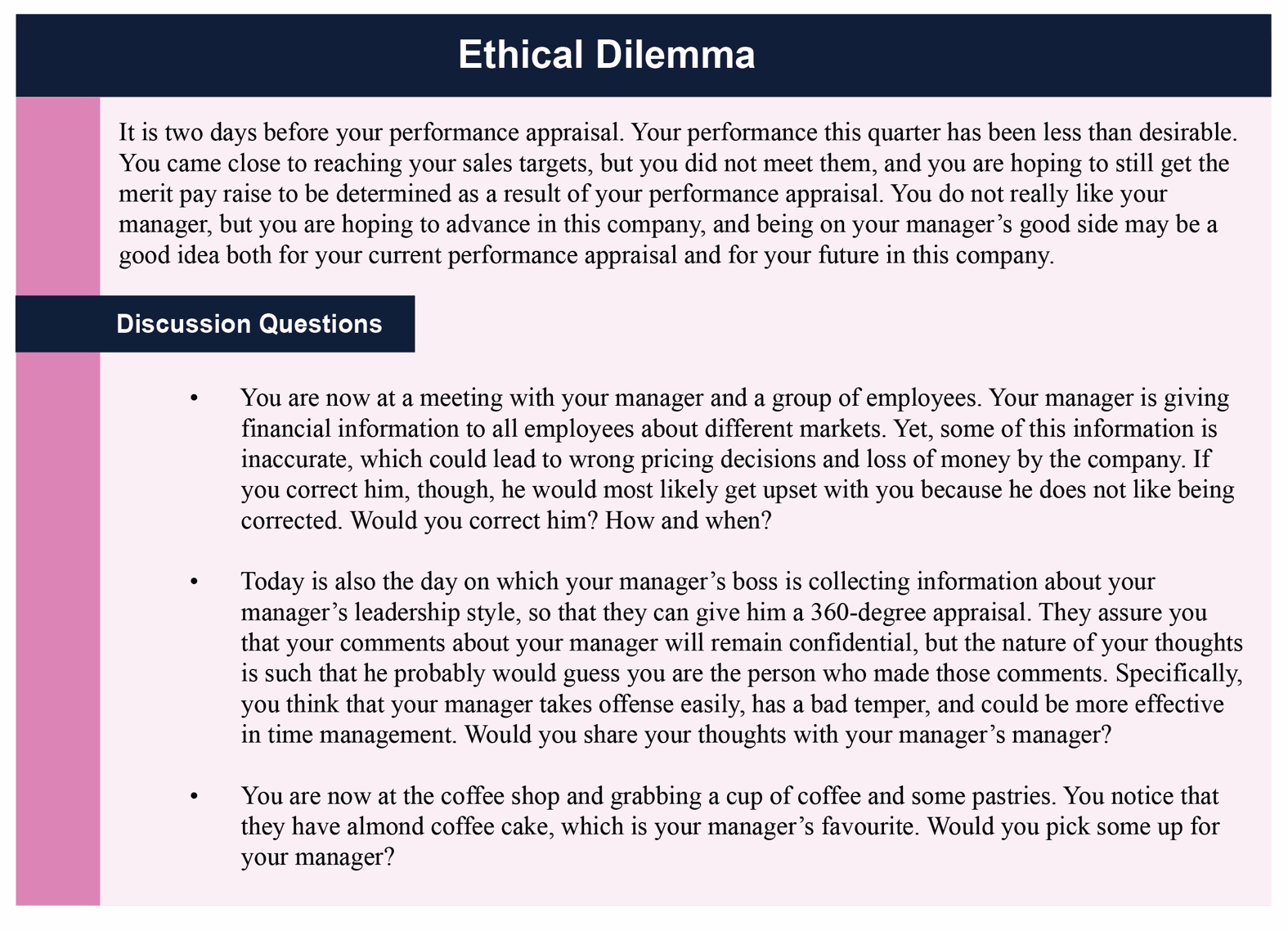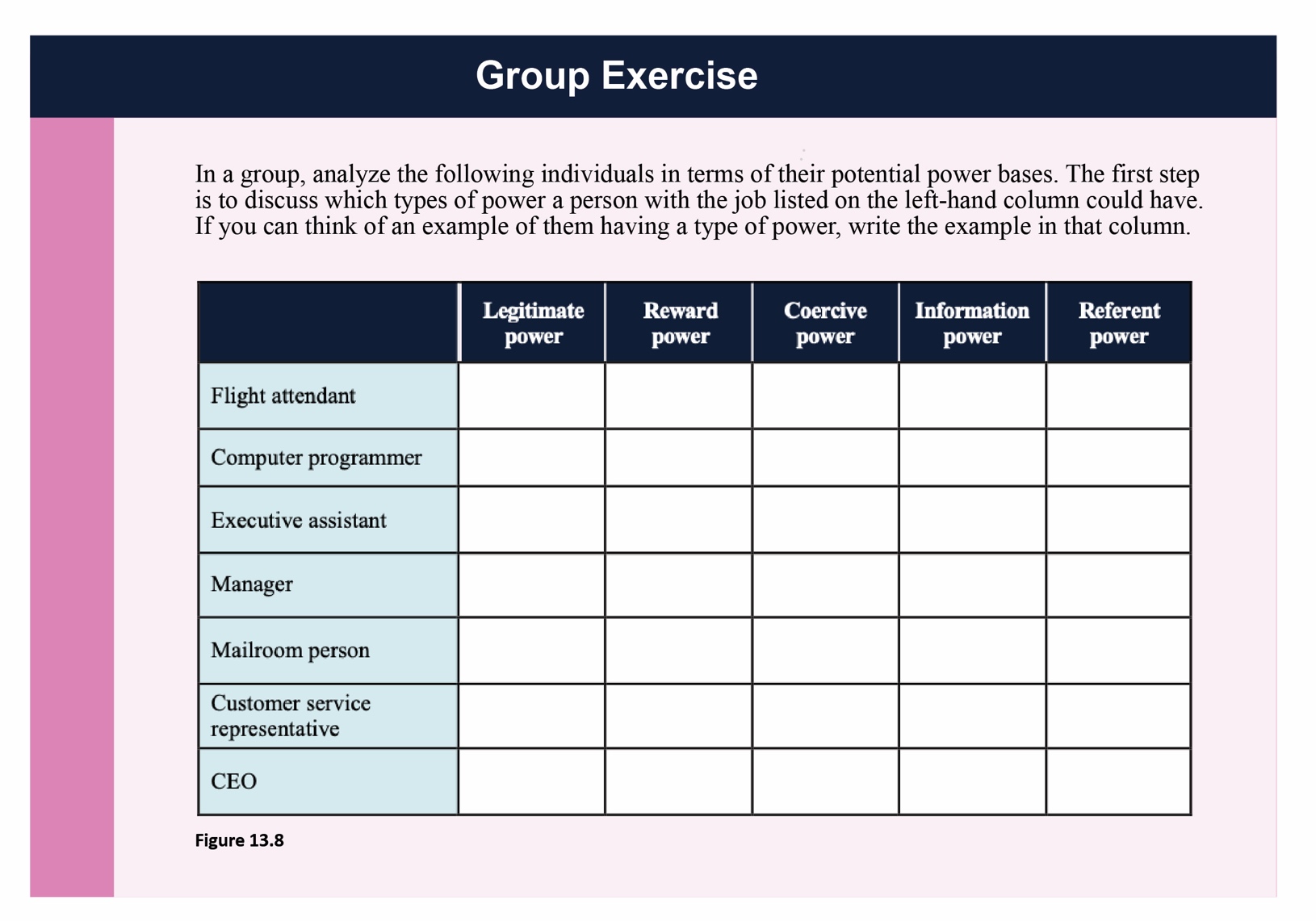Chapter 13: Power and Politics

Learning Objectives
After reading this chapter, you should be able to do the following:
- Understand the meaning of power.
- Recognize the positive and negative aspects of power and influence.
- Recognize the sources of power.
- Understand and recognize influence tactics and impression management.
- Learn the definition of a social network and how to analyze your own network.
- Understand the antecedents and consequences of organizational politics.
- Understand how ethics affect power.
- Understand cross-cultural influences on power use.
Video Connection: If you are interested in learning more about Steve Jobs as he describes pivotal moments in his life, view Steve Jobs’s commencement speech at Stanford in 2005, available at the following Web site: http://www.youtube.com/watch?v=UF8uR6Z6KLc
13.1 Focus on Power: The Case of Steve Jobs
In 2007, Fortune named Steve Jobs the “Most Powerful Person in Business.” In 2009, the magazine named him “CEO of the Decade.” Jobs, CEO of Apple Inc. (NASDAQ: AAPL), has transformed no fewer than five different industries: computers, Hollywood movies, music, retailing, and wireless phones. His Apple II ushered in the personal computer era in 1977, and the graphical interface of the Macintosh in 1984 set the standard that all other PCs emulated. His company Pixar defined the computer-animated feature film. The iPod, iTunes, and iPhone revolutionized how we listen to music, how we pay for and receive all types of digital content, and what we expect of a mobile phone.

How has Jobs done it? Jobs draws on all six types of power: legitimate, expert, reward, information, coercive, and referent. His vision and sheer force of will helped him succeed as a young unknown. But the same determination that helped him succeed has a darker side—an autocracy and drive for perfection that can make him tyrannical. Let’s take each of these in turn.
- Legitimate power. As CEO of Apple, Jobs enjoys unquestioned legitimate power.
- Expert power. His success has built a tremendous amount of expert power. Jobs is renowned for being able to think of markets and products for needs that people didn’t even know they had.
- Reward power. As one of the richest individuals in the United States, Jobs has reward power both within and outside Apple. He also can reward individuals with his time and attention.
- Information power. Jobs has been able to leverage information in each industry he has transformed.
- Coercive power. Forcefulness is helpful when tackling large, intractable problems, says Stanford social psychologist Roderick Kramer, who calls Jobs one of the “great intimidators.” Robert Sutton notes that “the degree to which people in Silicon Valley are afraid of Jobs is unbelievable.” Jobs is known to berate people to the point of tears.
- Referent power. But at the same time, “He inspires astounding effort and creativity from his people.” Employee Andy Herzfeld, the lead designer of the original Mac operating system, says Jobs imbues employees with a “messianic zeal” and can make them feel that they’re working on the greatest product in the world.
Those who work with him say Jobs is very hard to please. However, they also say that this means that Apple employees work hard to win his approval. “He has the ability to pull the best out of people,” says Cordell Ratzlaff, who worked closely with Jobs on OS X for 18 months. “I learned a tremendous amount from him.” Jobs’s ability to persuade and influence has come to be called a “reality distortion field.” As Bud Tribble put it, “In his presence, reality is malleable. He can convince anyone of practically anything.” Hertzfeld describes his style as “a confounding mélange of a charismatic rhetorical style, an indomitable will, and an eagerness to bend any fact to fit the purpose at hand.” The influence works even when you’re aware of it, and it works even on “enemies”: “No other high-tech impresario could walk into the annual sales meeting of one of his fiercest rivals and get a standing ovation,” which is what Jobs got in 2002 from Intel Corporation (the ally of Apple archrival Microsoft in the partnership known as Wintel: Windows + Intel).
Jobs’s power is not infallible—he was ousted from his own company in 1987 by the man he hired to help him run it. But he returned in 1997 and brought the company back from the brink of failure. The only years that Apple was unprofitable were the years during Jobs’s absence. Many watched to see how Apple and Jobs succeed with the iPad in 2010 (Hertzfeld, 1981; Kahney. 2008; Schlender, 2007; Sutton, 2007).
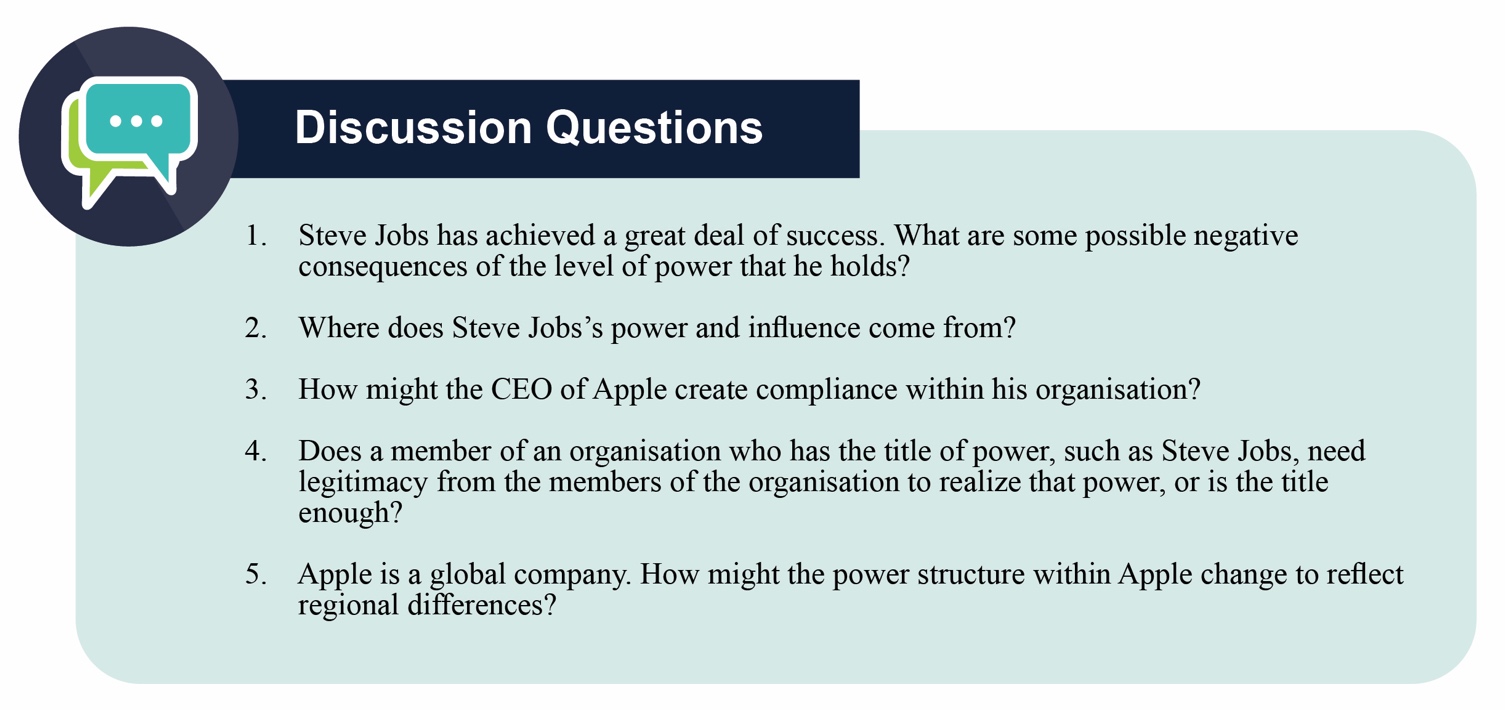
13.2 The Basics of Power
What Is Power?
We’ll look at the aspects and nuances of power in more detail in this chapter, but simply put, power is the ability to influence the behaviour of others to get what you want. Gerald Salancik and Jeffery Pfeffer concur, noting, “Power is simply the ability to get things done the way one wants them to be done” (Salancik & Pfeffer, 1989). If you want a larger budget to open a new store in a large city and you get the budget increase, you have used your power to influence the decision.
Power distribution is usually visible within organizations. For example, Salancik and Pfeffer gathered information from a company with 21 department managers and asked 10 of those department heads to rank all the managers according to the influence each person had in the organization. Although ranking 21 managers might seem like a difficult task, all the managers were immediately able to create that list. When Salancik and Pfeffer compared the rankings, they found virtually no disagreement in how the top 5 and bottom 5 managers were ranked. The only slight differences came from individuals ranking themselves higher than their colleagues ranked them. The same findings held true for factories, banks, and universities.
Positive and Negative Consequences of Power
The fact that we can see and succumb to power means that power has both positive and negative consequences. On one hand, powerful CEOs can align an entire organization to move together to achieve goals. Amazing philanthropists such as Paul Farmer, a doctor who brought hospitals, medicine, and doctors to remote Haiti, and Greg Mortenson, a mountaineer who founded the Central Asia Institute and built schools across Pakistan, draw on their own power to organize others toward lofty goals; they have changed the lives of thousands of individuals in countries around the world for the better (Kidder, 2004; Mortenson & Relin, 2006).
On the other hand, autocracy can destroy companies and countries alike. The phrase, “Power tends to corrupt, and absolute power corrupts absolutely” was first said by English historian John Emerich Edward Dalberg, who warned that power was inherently evil and its holders were not to be trusted. History shows that power can be intoxicating and can be devastating when abused, as seen in high-profile cases such as those involving Enron Corporation and government leaders such as the impeached Illinois Governor Rod Blagojevich in 2009. One reason that power can be so easily abused is because individuals are often quick to conform. To understand this relationship better, we will examine some famous researchers who studied conformity in a variety of contexts.
Conformity
Conformity refers to people’s tendencies to behave consistently with social norms. Conformity can refer to small things such as how people tend to face forward in an elevator. There’s no rule listed in the elevator saying which way to face, yet it is expected that everyone will face forward. To test this, the next time you’re in an elevator with strangers, simply stand facing the back of the elevator without saying anything. You may notice that those around you become uncomfortable. Conformity can result to engaging unethical behaviours because you are led by someone you admire and respect who has power over you. Guards at Abu Ghraib said they were just following orders when they tortured prisoners (CNN.com, 2005). People conform because they want to fit in with and please those around them. There is also a tendency to look to others in ambiguous situations, which can lead to conformity. The response to “Why did you do that?” being “Because everyone else was doing it” sums up this tendency.
So, does conformity occur only in rare or extreme circumstances? Actually, this is not the case. Three classic sets of studies illustrate how important it is to create checks and balances to help individuals resist the tendency to conform or to abuse authority. To illustrate this, we will examine findings from the Milgram, Asch, and Zimbardo studies.
The Milgram Studies
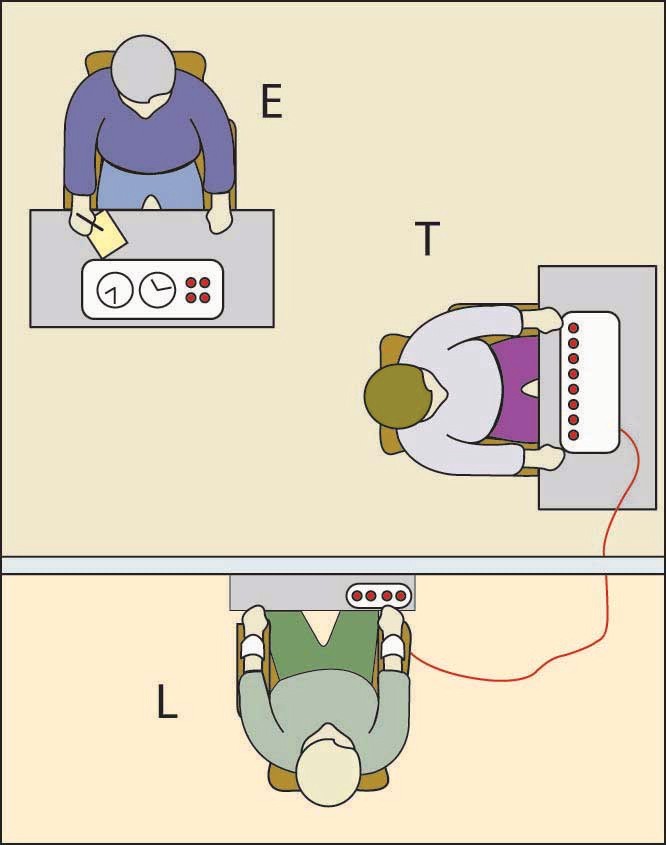
Stanley Milgram, a psychologist at Yale in the 1960s, set out to study conformity to authority. His work tested how far individuals would go in hurting another individual when told to do so by a researcher. A key factor in the Milgram study and others that will be discussed is the use of confederates, or people who seem to be participants but are actually paid by the researchers to take on a certain role. Participants believed that they were engaged in an experiment on learning. The participant (teacher) would ask a series of questions to another “participant” (learner). The teachers were instructed to shock the learners whenever an incorrect answer was given. The learner was not a participant at all but actually a confederate who would pretend to be hurt by the shocks and yell out in pain when the button was pushed. Starting at 15 volts of power, the participants were asked to increase the intensity of the shocks over time. Some expressed concern when the voltage was at 135 volts, but few stopped once they were told by the researcher that they would not personally be held responsible for the outcome of the experiment and that their help was needed to complete the experiment. In the end, all the participants were willing to go up to 300 volts, and a shocking 65% were willing to administer the maximum of 450 volts even as they heard screams of pain from the learner (Milgram, 1974).
The Zimbardo Study
Philip Zimbardo, a researcher at Stanford University, conducted a famous experiment in the 1970s (Zimbardo, 2009). While this experiment would probably not make it past the human subjects committee of schools today, at the time, he was authorized to place an ad in the paper that asked for male volunteers to help understand prison management. After excluding any volunteers with psychological or medical problems or with any history of crime or drug abuse, he identified 24 volunteers to participate in his study. Researchers randomly assigned 18 individuals to the role of prisoner or guard. Those assigned the role of “prisoners” were surprised when they were picked up by actual police officers and then transferred to a prison that had been created in the basement of the Stanford psychology building. The guards in the experiment were told to keep order but received no training. Zimbardo was shocked with how quickly the expected roles emerged. Prisoners began to feel depressed and helpless. Guards began to be aggressive and abusive. The original experiment was scheduled to last 2 weeks, but Zimbardo ended it after only 6 days upon seeing how deeply entrenched in their roles everyone, including himself, had become.
The Relationship Between Dependency and Power Dependency
Dependency is directly related to power. The more that a person is dependent on you, the more power you have over them. The strategic contingencies model provides a good description of how dependency works. According to the model, dependency is power that a person gains from their ability to handle actual or potential problems facing the organization (Saunders, 1990). You know how dependent you are on someone when you answer three key questions that are addressed in the following sections.
Scarcity
Scarcity refers to the uniqueness of a resource. The more difficult something is to obtain, the more valuable it tends to be. Sales people, for example, exploit this reality by making an opportunity or offer seem more attractive because it is limited or exclusive. At work, a manager might convince you to take on a project because “it’s rare to get a chance to work on a new project like this,” or “you have to sign on today because if you don’t, I have to offer it to someone else.”
Importance
Importance refers to the value of the resource. The key question here is “how important is this?” If the resources or skills you control are vital to the organization, you will gain some power. The more vital the resources that you control are, the more power you will have. For example, if Kecia is the only person who knows how to fill out reimbursement forms, it is important that you are able to work with her, because getting paid back for business trips and expenses is important to most of us.
Substitutability
Finally, substitutability refers to one’s ability to find another option that works as well as the one offered. The question around whether something is substitutable is “how difficult would it be for me to find another way to this?” The harder it is to find a substitute, the more dependent the person becomes and the more power someone else has over them. If you are the only person who knows how to make a piece of equipment work, you will be very powerful in the organization. This is true unless another piece of equipment is brought in to serve the same function. At that point, your power would diminish. Similarly, countries with large supplies of crude oil have traditionally had power to the extent that other countries need oil to function. As the price of oil climbs, alternative energy sources such as wind, solar, and hydropower become more attractive to investors and governments. For example, in response to soaring fuel costs and environmental concerns, in 2009 Japan Airlines successfully tested a blend of aircraft fuel made from a mix of camelina, jatropha, and algae on the engine of a Boeing 747-300 aircraft (Krauss, 2009).

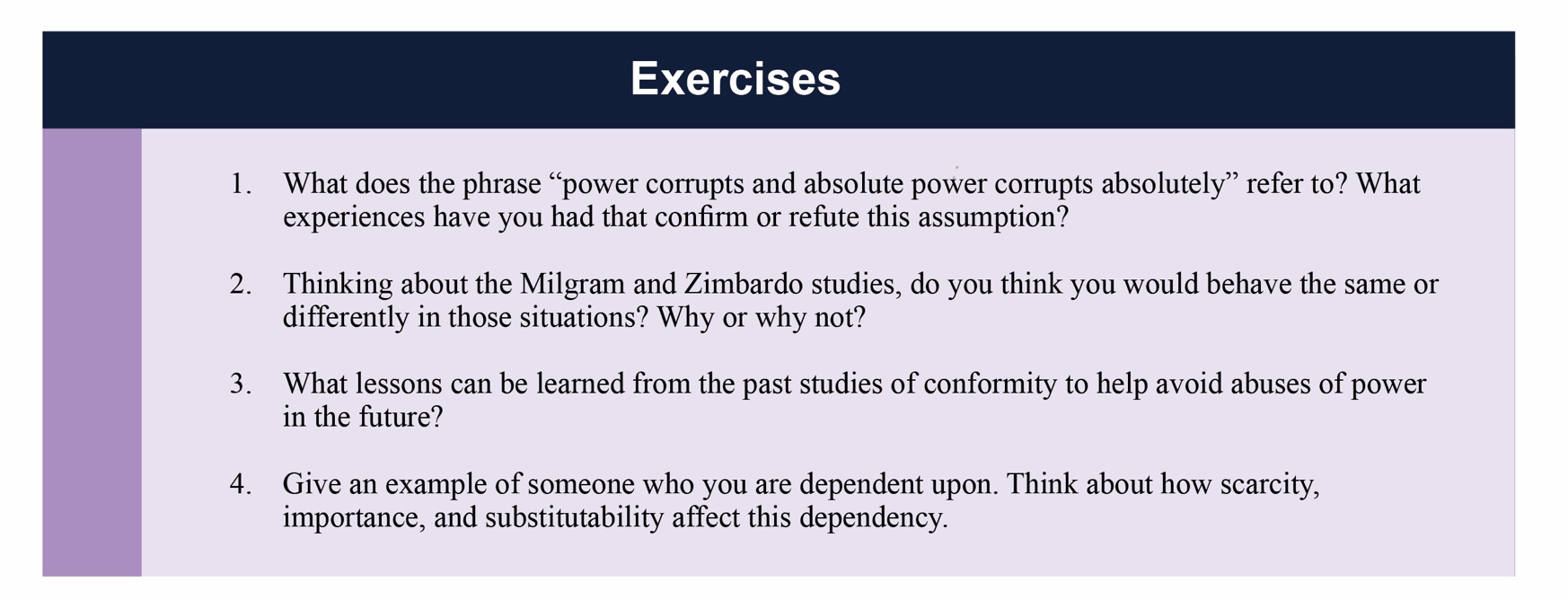
13.2 The Power to Influence
Sources of Power

Having power and using power are two different things. For example, imagine a manager who has the power to reward or punish employees. When the manager makes a request, he or she will probably be obeyed even though the manager does not actually reward the employee. The fact that the manager has the ability to give rewards and punishments will be enough for employees to follow the request. What are the sources of one’s power over others? Researchers identified six sources of power, which include legitimate, reward, coercive, expert, information, and referent (French & Raven, 1960). You might earn power from one source or all six depending on the situation. Let us take a look at each of these in turn and continue with Steve Jobs from the opening case as our example.
Legitimate Power
Legitimate power is power that comes from one’s organizational role or position. For example, a boss can assign projects, a policeman can arrest a citizen, and a teacher assigns grades. Others comply with the requests these individuals make because they accept the legitimacy of the position, whether they like or agree with the request or not. Steve Jobs has enjoyed legitimate power as the CEO of Apple. He could set deadlines and employees comply even if they think the deadlines were overly ambitious. Start-up organizations often have founders who use their legitimate power to influence individuals to work long hours week after week in order to help the company survive.
Reward Power
Reward power is the ability to grant a reward, such as an increase in pay, a perk, or an attractive job assignment. Reward power tends to accompany legitimate power and is highest when the reward is scarce. Anyone can wield reward power, however, in the form of public praise or giving someone something in exchange for their compliance. When Steve Jobs ran Apple, he had reward power in the form of raises and promotions. Another example of reward power comes from Bill Gross, founder of Idealab, who has the power to launch new companies or not. He created his company with the idea of launching other new companies as soon as they could develop viable ideas. If members could convince him that their ideas were viable, he gave the company a maximum of $250,000 in seed money, and gave the management team and employees a 30% stake in the company and the CEO 10% of the company. That way, everyone had a stake in the company. The CEO’s salary was capped at $75,000 to maintain the sense of equity. When one of the companies, Citysearch, went public, all employees benefited from the $270 million valuation.
Coercive Power
In contrast, coercive power is the ability to take something away or punish someone for noncompliance. Coercive power often works through fear and it forces people to do something that ordinarily they would not choose to do. The most extreme example of coercion is government dictators who threaten physical harm for noncompliance. Parents may also use coercion such as grounding their child as punishment for noncompliance. Steve Jobs has been known to use coercion—yelling at employees and threatening to fire them. When John Wiley & Sons Inc. published an unauthorized biography of Jobs, Jobs’s response was to prohibit sales of all books from that publisher in any Apple retail store (Hafner, 2005). In other examples, John D. Rockefeller was ruthless when running Standard Oil Company. He not only undercut his competitors through pricing, but he used his coercive power to get railroads to refuse to transport his competitor’s products. American presidents have been known to use coercion power. President Lyndon Baines Johnson once told a White House staffer, “Just you remember this. There’s only two kinds at the White house. There’s elephants and there’s ants. And I’m the only elephant” (Hughes, Ginnet, & Curphy, 1995).
Expert Power
Expert power comes from knowledge and skill. Steve Jobs has expert power from his ability to know what customers want—even before they can articulate it. Others who have expert power in an organization include long-time employees, such as a steelworker who knows the temperature combinations and length of time to get the best yields. Technology companies are often characterized by expert, rather than legitimate power. Many of these firms utilize a flat or matrix structure in which clear lines of legitimate power become blurred as everyone communicates with everyone else regardless of position.
Information Power
Information power is similar to expert power but differs in its source. Experts tend to have a vast amount of knowledge or skill, whereas information power is distinguished by access to specific information. For example, knowing price information gives a person information power during negotiations. Within organizations, a person’s social network can either isolate them from information power or serve to create it. As we will see later in this chapter, those who are able to span boundaries and serve to connect different parts of the organizations often have a great deal of information power. In the TV show Mad Men, which is set in the 1960s, it is clear that the switchboard operators have a great deal of information power as they place all calls and are able to listen in on all the phone conversations within the advertising firm.

Referent Power
Referent power stems from the personal characteristics of the person such as the degree to which we like, respect, and want to be like them. Referent power is often called charisma—the ability to attract others, win their admiration, and hold them spellbound. Steve Jobs’s influence as described in the opening case is an example of this charisma.
Influence
Starting from when we are babies, we all try to get others to do what we want. We learn early what works in getting us to our goals. Instead of crying and throwing a tantrum, we may figure out that smiling and using language causes everyone less stress and brings us the rewards we seek.
By the time you hit the workplace, you have had vast experience with influence techniques. You have probably picked out a few that you use most often. To be effective in a wide number of situations, however, it’s best to expand your repertoire of skills and become competent in several techniques, knowing how and when to use them as well as understanding when they are being used on you. If you watch someone who is good at influencing others, you will most probably observe that person switching tactics depending on the context. The more tactics you have at your disposal, the more likely it is that you will achieve your influence goals.
Al Gore and many others have spent years trying to influence us to think about the changes in the environment and the implications of global warming. They speak, write, network, and lobby to get others to pay attention. But Gore, for example, does not stop there. He also works to persuade us with direct, action-based suggestions such as asking everyone to switch the kind of light bulbs they use, turn off appliances when not in use, drive vehicles with better fuel economy, and even take shorter showers. Ironically, Gore has more influence now as a private citizen regarding these issues than he was able to exert as a congressman, senator, and vice president of the United States.
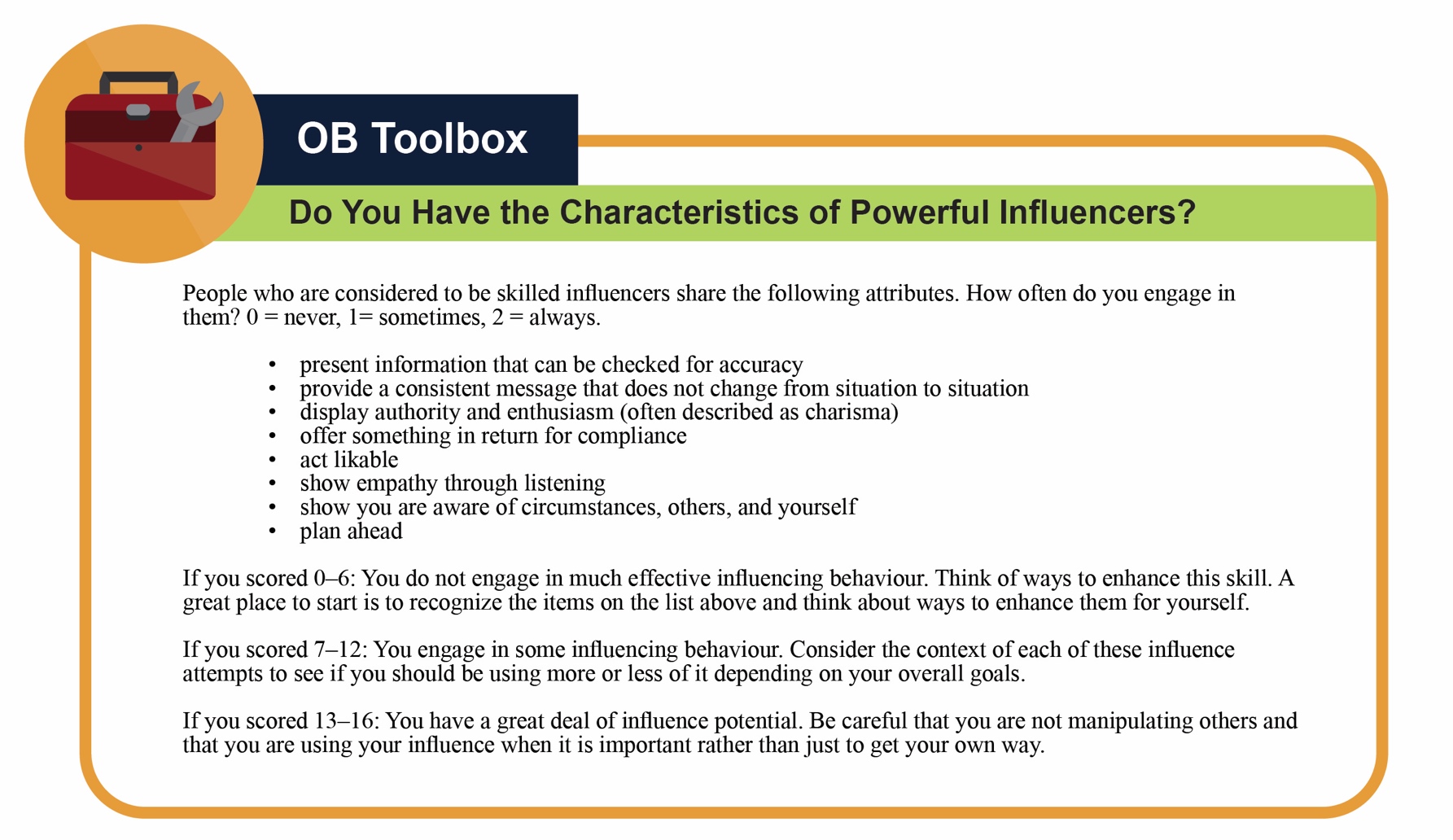
Commonly Used Influence Tactics
Researchers have identified distinct influence tactics and discovered that there are few differences between the way bosses, subordinates, and peers use them, which we will discuss at greater depth later on in this chapter. We will focus on nine influence tactics. Responses to influence attempts include resistance, compliance, or commitment. Resistance occurs when the influence target does not wish to comply with the request and either passively or actively repels the influence attempt. Compliance occurs when the target does not necessarily want to obey, but they do. Commitment occurs when the target not only agrees to the request but also actively supports it as well. Within organizations, commitment helps to get things done because others can help to keep initiatives alive long after compliant changes have been made or resistance has been overcome.
- Rational persuasion includes using facts, data, and logical arguments to try to convince others that your point of view is the best alternative. This is the most commonly applied influence tactic. One experiment illustrates the power of reason. People were lined up at a copy machine and another person, after joining the line asked, “May I go to the head of the line?” Amazingly, 63% of the people in the line agreed to let the requester jump ahead. When the line jumper makes a slight change in the request by asking, “May I go to the head of the line because I have copies to make?” the number of people who agreed jumped to over 90%. The word because was the only difference. Effective rational persuasion includes the presentation of factual information that is clear and specific, relevant, and timely. Across studies summarized in a meta-analysis, rationality was related to positive work outcomes (Higgins, Judge, & Ferris, 2003).
- Inspirational appeals seek to tap into our values, emotions, and beliefs to gain support for a request or course of action. When President John F. Kennedy said, “ask not what your country can do for you, ask what you can do for your country,” he appealed to the higher selves of an entire nation. Effective inspirational appeals are authentic, personal, big-thinking, and enthusiastic.
- Consultation refers to the influence agent’s asking others for help in directly influencing or planning to influence another person or group. Consultation is most effective in organizations and cultures that value democratic decision making.
- Ingratiation refers to different forms of making others feel good about themselves. Ingratiation includes any form of flattery done either before or during the influence attempt. Research shows that ingratiation can affect individuals. For example, in a study of résumés, those résumés that were accompanied with a cover letter containing ingratiating information were rated higher than résumés without this information. Other than the cover letter accompanying them, the résumés were identical (Varma, Toh, & Pichler, 2006). Effective ingratiation is honest, infrequent, and well-intended.
- Personal appeal refers to helping another person because you like them and they asked for your help. We enjoy saying yes to people we know and like. A famous psychological experiment showed that in dorms, the most well-liked people were those who lived by the stairwell—they were the most often seen by others who entered and left the hallway. The repeated contact brought a level of familiarity and comfort. Therefore, personal appeals are most effective with people who know and like you.
- Exchange refers to give-and-take in which someone does something for you, and you do something for them in return. The rule of reciprocation says that “we should try to repay, in kind, what another person has provided us” (Cialdini, 2000). The application of the rule obliges us and makes us indebted to the giver. One experiment illustrates how a small initial gift can open people to a substantially larger request at a later time. One group of subjects was given a bottle of Coke. Later, all subjects were asked to buy raffle tickets. On the average, people who had been given the drink bought twice as many raffle tickets as those who had not been given the unsolicited drinks.
- Coalition tactics refer to a group of individuals working together toward a common goal to influence others. Common examples of coalitions within organizations are unions that may threaten to strike if their demands are not met. Coalitions also take advantage of peer pressure. The influencer tries to build a case by bringing in the unseen as allies to convince someone to think, feel, or do something. A well-known psychology experiment draws upon this tactic. The experimenters stare at the top of a building in the middle of a busy street. Within moments, people who were walking by in a hurry stop and also look at the top of the building, trying to figure out what the others are looking at. When the experimenters leave, the pattern continues, often for hours. This tactic is also extremely popular among advertisers and businesses that use client lists to promote their goods and services. The fact that a client bought from the company is a silent testimonial.
- Pressure refers to exerting undue influence on someone to do what you want or else something undesirable will occur. This often includes threats and frequent interactions until the target agrees. Research shows that managers with low referent power tend to use pressure tactics more frequently than those with higher referent power (Yukl, Kim, & Falbe, 1996). Pressure tactics are most effective when used in a crisis situation and when they come from someone who has the other’s best interests in mind, such as getting an employee to an employee assistance program to deal with a substance abuse problem.
- Legitimating tactics occur when the appeal is based on legitimate or position power. “By the power vested in me…”: This tactic relies upon compliance with rules, laws, and regulations. It is not intended to motivate people but to align them behind a direction. Obedience to authority is filled with both positive and negative images. Position, title, knowledge, experience, and demeanor grant authority, and it is easy to see how it can be abused. If someone hides behind people’s rightful authority to assert themselves, it can seem heavy-handed and without choice. You must come across as an authority figure by the way you act, speak, and look. Think about the number of commercials with doctors, lawyers, and other professionals who look and sound the part, even if they are actors. People want to be convinced that the person is an authority worth heeding. Authority is often used as a last resort. If it does not work, you will not have much else to draw from in your goal to persuade someone.
From the Best-Seller’s List: Making OB Connections
You can make more friends in two months by becoming interested in other people than you can in two years by trying to get other people interested in you.
– Dale Carnegie
How to Make Friends and Influence People was written by Dale Carnegie in 1936 and has sold millions of copies worldwide. While this book first appeared over 70 years ago, the recommendations still make a great deal of sense regarding power and influence in modern-day organizations. For example, he recommends that in order to get others to like you, you should remember six things:
- Become genuinely interested in other people.
- Smile.
- Remember that a person’s name is to that person the sweetest and most important sound in any language.
- Be a good listener. Encourage others to talk about themselves.
- Talk in terms of the other person’s interests.
- Make the other person feel important—and do it sincerely.
This book relates to power and politics in a number of important ways. Carnegie specifically deals with enhancing referent power. Referent power grows if others like, respect, and admire you. Referent power is more effective than formal power bases and is positively related to employees’ satisfaction with supervision, organizational commitment, and performance. One of the keys to these recommendations is to engage in them in a genuine manner. This can be the difference between being seen as political versus understanding politics.
Impression Management
Impression management means actively shaping the way you are perceived by others. You can do this through your choice of clothing, the avatars or photos you use to represent yourself online, the descriptions of yourself on a résumé or in an online profile, and so forth. By using impression management strategies, you control information that make others see you in the way you want to be seen. Consider when you are “being yourself” with your friends or with your family—you probably act differently around your best friend than around your mother (Dunn & Forrin, 2005).
On the job, the most effective approach to impression management is to do two things at once—build credibility and maintain authenticity. As Harvard Business School Professor Laura Morgan Roberts puts it, “when you present yourself in a manner that is both true to self and valued and believed by others, impression management can yield a host of favorable outcomes for you, your team, and your organization” (Stark, 2005).
There may be aspects of your “true self” that you choose not to disclose at work, although you would disclose them to your close friends. That kind of impression management may help to achieve group cohesiveness and meet professional expectations. But if you try to win social approval at work by being too different from your true self—contradicting your personal values—you might feel psychological distress.
It’s important to keep in mind that whether you’re actively managing your professional image or not, your coworkers are forming impressions of you. They watch your behaviour and draw conclusions about the kind of person you are, whether you’ll keep your word, whether you’ll stay to finish a task, and how you’ll react in a difficult situation.
Since people are forming these theories about you no matter what, you should take charge of managing their impressions of you. To do this, ask yourself how you want to be seen. What qualities or character traits do you want to convey? Perhaps it’s a can-do attitude, an ability to mediate, an ability to make a decision, or an ability to dig into details to thoroughly understand and solve a problem.
Then, ask yourself what the professional expectations are of you and what aspects of your social identity you want to emphasize or minimize in your interactions with others. If you want to be seen as a leader, you might disclose how you organized an event. If you want to be seen as a caring person in whom people can confide, you might disclose that you’re a volunteer on a crisis helpline. You can use a variety of impression management strategies to accomplish the outcomes you want.
Upward Influence
Upward influence, as its name implies, is the ability to influence your boss and others in positions higher than yours. Upward influence may include appealing to a higher authority or citing the firm’s goals as an overarching reason for others to follow your cause. Upward influence can also take the form of an alliance with a higher status person (or with the perception that there is such an alliance) (Farmer & Maslyn, 1999; Farmer et al., 1997). As complexity grows, the need for this upward influence grows as well—the ability of one person at the top to know enough to make all the decisions becomes less likely. Moreover, even if someone did know enough, the sheer ability to make all the needed decisions fast enough is no longer possible. This limitation means that individuals at all levels of the organization need to be able to make and influence decisions. By helping higher-ups be more effective, employees can gain more power for themselves and their unit as well. On the flip side, allowing yourself to be influenced by those reporting to you may build your credibility and power as a leader who listens. Then, during a time when you do need to take unilateral, decisive action, others will be more likely to give you the benefit of the doubt and follow. Both Asian American and Caucasian American managers report using different tactics with superiors than those used with their subordinates (Xin & Tsui, 1996). Managers reported using coalitions and rationality with managers and assertiveness with subordinates. Other research establishes that subordinates’ use of rationality, assertiveness, and reciprocal exchange was related to more favorable outcomes such as promotions and raises, while self-promotion led to more negative outcomes (Orpen, 1996; Wayne et al., 1997).
Downward Influence
Downward influence is the ability to influence employees lower than you. This is best achieved through an inspiring vision. By articulating a clear vision, you help people see the end goal and move toward it. You often don’t need to specify exactly what needs to be done to get there—people will be able to figure it out on their own. An inspiring vision builds buy-in and gets people moving in the same direction. Research conducted within large savings banks shows that managers can learn to be more effective at influence attempts. The experimental group of managers received a feedback report and went through a workshop to help them become more effective in their influence attempts. The control group of managers received no feedback on their prior influence attempts. When subordinates were asked 3 months later to evaluate potential changes in their managers’ behaviour, the experimental group had much higher ratings of the appropriate use of influence (Seifer, Yukl, & McDonald, 2003). Research also shows that the better the quality of the relationship between the subordinate and their supervisor, the more positively resistance to influence attempts are seen (Tepper et al., 2006). In other words, bosses who like their employees are less likely to interpret resistance as a problem.
Peer Influence
Peer influence occurs all the time. But, to be effective within organizations, peers need to be willing to influence each other without being destructively competitive (Cohen & Bradford, 2002). There are times to support each other and times to challenge—the end goal is to create better decisions and results for the organization and to hold each other accountable. Executives spend a great deal of their time working to influence other executives to support their initiatives. Research shows that across all functional groups of executives, finance, or human resources as an example, rational persuasion is the most frequently used influence tactic (Enns & McFarlin, 2003).
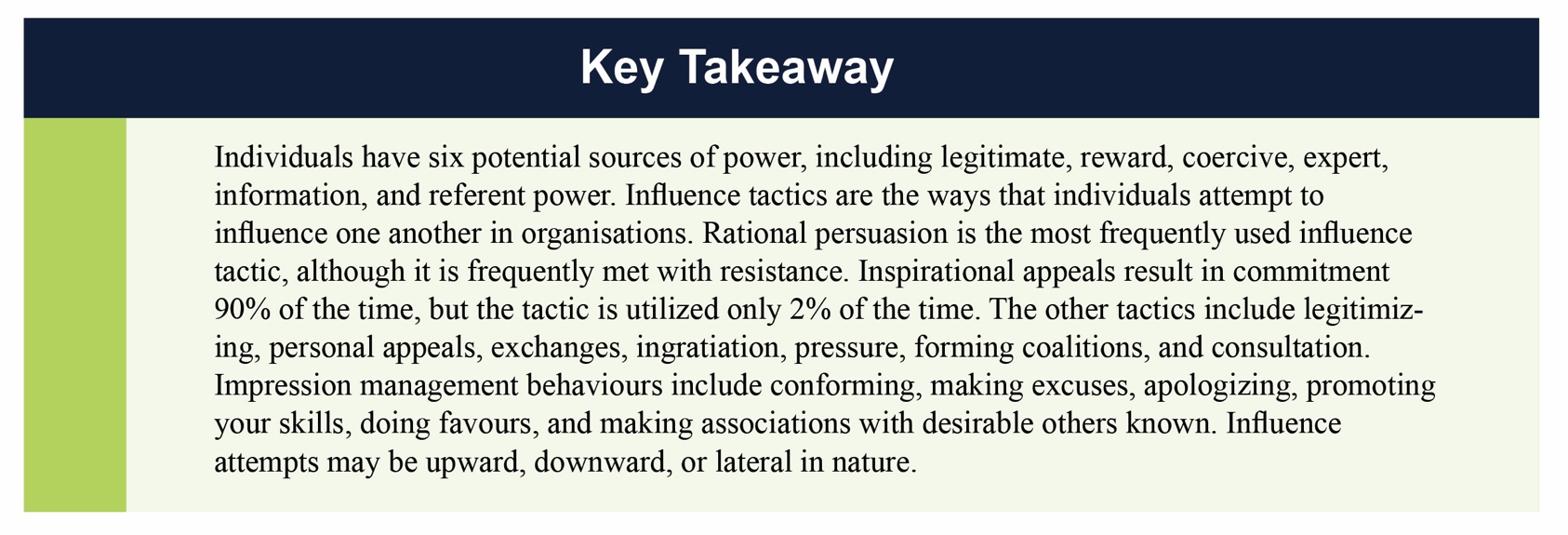
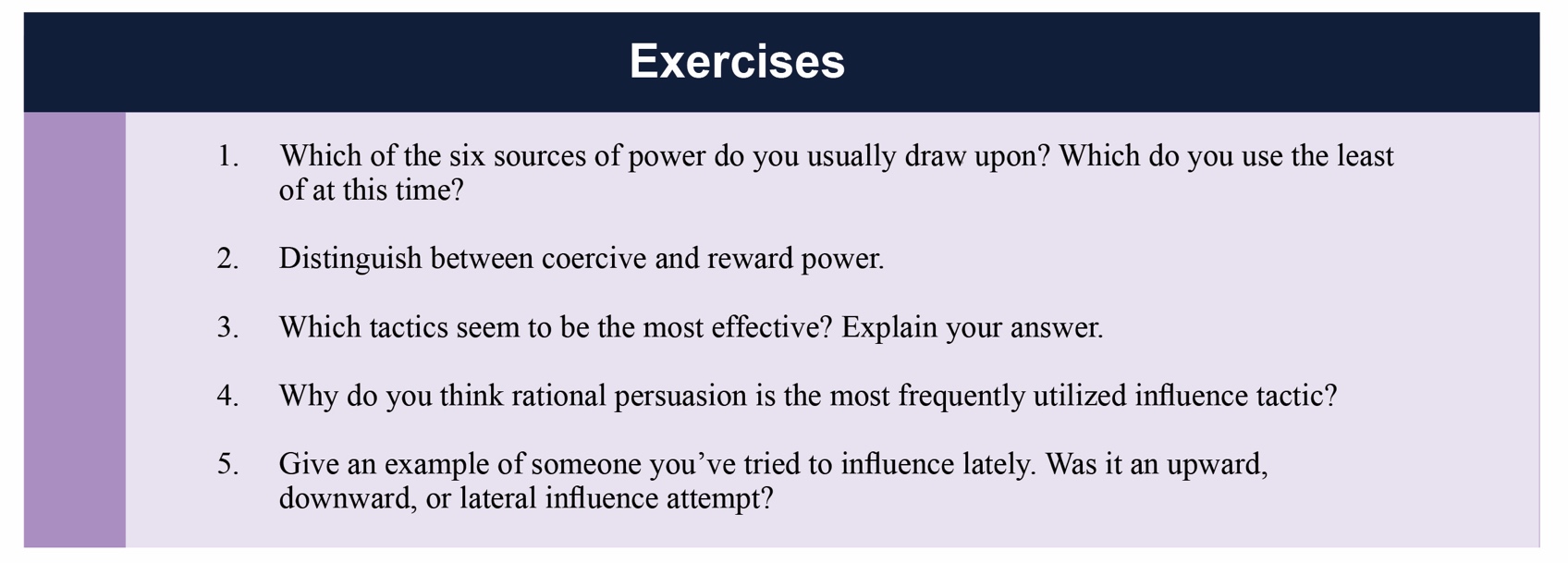
13.3 Organizational Politics
Organizational Politics
Organizational politics are informal, unofficial, and sometimes behind-the-scenes efforts to sell ideas, influence an organization, increase power, or achieve other targeted objectives (Brandon & Seldman, 2004; Hochwarter, Witt, & Kacmar, 2000). Politics has been around for millennia. Aristotle wrote that politics stems from a diversity of interests, and those competing interests must be resolved in some way. “Rational” decision making alone may not work when interests are fundamentally incongruent, so political behaviours and influence tactics arise.
Today, work in organizations requires skill in handling conflicting agendas and shifting power bases. Effective politics isn’t about winning at all costs but about maintaining relationships while achieving results. Although often portrayed negatively, organizational politics are not inherently bad. Instead, it’s important to be aware of the potentially destructive aspects of organizational politics in order to minimize their negative effect. Of course, individuals within organizations can waste time overly engaging in political behaviour. Research reported in HR Magazine found that managers waste 20% of their time managing politics. However, as John Kotter wrote in Power and Influence, “without political awareness and skill, we face the inevitable prospect of becoming immersed in bureaucratic infighting, parochial politics, and destructive power struggles, which greatly retard organizational initiative, innovation, morale, and performance” (Kotter, 1985).
In our discussion about power, we saw that power issues often arise around scarce resources. Organizations typically have limited resources that must be allocated in some way. Individuals and groups within the organization may disagree about how those resources should be allocated, so they may naturally seek to gain those resources for themselves or for their interest groups, which gives rise to organizational politics. Simply put, with organizational politics, individuals ally themselves with like-minded others in an attempt to win the scarce resources. They’ll engage in behaviour typically seen in government organizations, such as bargaining, negotiating, alliance building, and resolving conflicting interests.
Politics are a part of organizational life, because organizations are made up of different interests that need to be aligned. In fact, 93% of managers surveyed reported that workplace politics exist in their organization, and 70% felt that in order to be successful, a person has to engage in politics (Gandz & Murray, 1980). In the negative light, saying that someone is “political” generally stirs up images of backroom dealing, manipulation, or hidden agendas for personal gain. A person engaging in these types of political behaviours is said to be engaging in self-serving behaviour that is not sanctioned by the organization (Ferris et al., 1996; Valle & Perrewe, 2000; Harris, James, & Boonthanom, 2005; Randall et al., 1999).
Examples of these self-serving behaviours include bypassing the chain of command to get approval for a special project, going through improper channels to obtain special favours, or lobbying high-level managers just before they make a promotion decision. These types of actions undermine fairness in the organization because not everyone engages in politicking to meet their own objectives. Those who follow proper procedures often feel jealous and resentful because they perceive unfair distributions of the organization’s resources, including rewards and recognition (Parker, Dipboye, & Jackson, 1995).
13.4 Understanding Social Networks
Social Networks
We’ve seen that power comes from many sources. One major source relates to who you know and how much access you have to information within your organization. Social networks are visual maps of relationships between individuals. They are vital parts of organizational life as well as important when you are first looking for a job. For example, if you are interested in being hired by Proctor & Gamble, you might call upon your social network—the network of people you know—to find the people who can help you accomplish this task. You might ask your network if they know anyone at Proctor & Gamble. If you did so, the people you’d call on aren’t just your friends and family—they’re part of your informal network. In fact, research finds that 75% to 95% of all jobs are never formally advertised but are filled through such social networks (Hansen, 2008).

Much of the work that gets done in organizations is done through informal networks as well. Networks serve three important functions. First, they deliver private information. Second, they allow individuals to gain access to diverse skills sets. Third, they can help create power.
Social networks connect people with others. Consider networking websites such as Facebook or LinkedIn, where being connected with many people makes you more visible. In business, the more central you are, the more power you will have. The closer you are to more people, the more powerful you are (Cross, Parker, & Cross, 2004). If you are the person who many people link to and you serve as a node between people, you have brokering power—you can introduce people to each other. People high on this “betweenness” are also in a position to withhold information from one person to the next, which can happen during power plays. You also have a greater number of people to call on when you need something, which makes you less dependent on any one person. The more ties you have that are incoming (toward you), the more trusted you are.
Social network analysis shows who communicates with whom, who knows whom, and where gaps in communication or collaboration may exist. After conducting a network analysis, organizations can take actions to modify people’s roles or responsibilities in ways that improve communication or diffuse innovation throughout the organization more effectively by putting people or departments in touch with each other.
Building Your Own Network

There are several simple steps you can take to help build your own social network. For example, you can go to lunch with someone new. You can also try to do more to encourage, help, and share with others. You can seek information outside your own class or work group. You can spend time with people from work outside work. All these suggestions are effective ways to naturally build your social network.
13.5 The Role of Ethics and National Culture
Ethics and Power
Power brings a special need for ethics, because the circumstances of power make it easy for misuse to occur. As we have seen, a company president wields at least three sources of power: legitimate from the position they hold, coercive from the ability to fire employees, and reward such as the ability to give raises and perks. Expert power and referent power often enter the mix as well. Now take the example of setting the CEO’s pay. In a public company, the CEO presumably has to answer to the board of directors and the shareholders. But what if the CEO appoints many of the people on the board? What if the board and the CEO are friends? Consider the case of Richard Grasso, former chairman of the New York Stock Exchange (NYSE), whose compensation was $140 million plus another $48 million in retirement benefits. At that time, the average starting salary of a trader on the NYSE was $90,000, so Grasso was being paid 1,555 times more than a starting employee. The NYSE Board of Directors approved Grasso’s payment package, but many of the board members had been appointed to their positions by Grasso himself. What’s more, the NYSE’s function is to regulate publicly traded companies. As Hartman and Desjardins noted, “the companies being regulated by the NYSE were the very same companies that were paying Grasso” (Hartman & Desjardins, 2008). Grasso ultimately resigned amid public criticism but kept the $140 million. Other CEOs have not faced the same outcry, even though average CEO pay increased 200% to 400% during the same time period that average worker pay increased only 4.3% (CEO paycharts, 2005). Some CEOs have earned a great deal of respect by limiting what they are paid. For example, Japan Airlines CEO Haruka Nishimatsu earns the equivalent to $90,000 per year while running the 10th largest airline in the world. In addition, he rides the bus to work and eats in the company cafeteria with everyone else (Petersen, 2009).
Video Connection: Haruka NishimatsuIf you are interested in learning more about CEO Haruka Nishimatsu, view this CBS News video segment, available at the following Web site: http://www.cbsnews.com/video/watch/?id=4761187n
13.5 Getting Connected: The Case of Social Networking
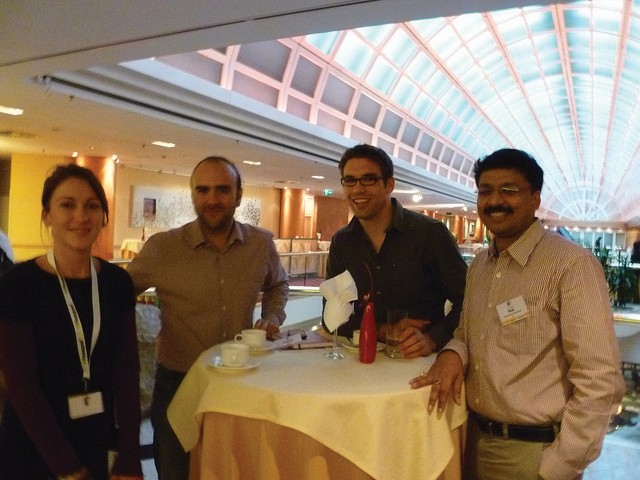
Networking has the potential to open doors and create possibilities for jobs and partnerships. Networking establishes connections between individuals and access to information that one might not normally have access to. Reaching out to strangers can be an intimidating and nerve-racking experience. In business, the more central you are, the more power you have. Creating connections and ties to other people affords you the opportunity for power and the ability to more closely control your future, so while at times networking might feel awkward and uncomfortable, it is a necessary and important part of establishing and maintaining a career.
Online social networking sites play an important role in this networking process for individuals both professionally and personally. With 1,200 employees in 2010, Facebook has 350 million users around the world, and LinkedIn has over 60 million members in over 200 countries. A new member joins LinkedIn every second, and about half of the members are outside the United States. These online sites have created new opportunities for networking and allow individuals to branch out beyond their normal world of industry, school, and business. The key is to avoid costly missteps as employers have begun to search online for information about prospective and current employees. In 2009, 8% of companies reported that they had fired an employee for misuse of social media.
Many of these online sites have become a tool for business. For example, LinkedIn targets working professionals and provides them a way to maintain lists of business connections and to use those connections to gain used by professionals. The power of social networking flows in both directions. Employers can screen applicants through their online accounts and recruiters more than ever are using these sites to view background information, individual skill sets, and employment history, which can be cross-referenced with submitted applications. Job seekers can review the profiles of those at top management firms and search for mutual contacts. LinkedIn also provides statistics about firms, which can be useful information for individuals looking at potential employers.
Networking is about building your brand and managing relationships. Using social networks as a vehicle to market one’s self and make professional connections is becoming increasingly common, as well as using loose ties or connections through others to open doors and land jobs. In an increasingly high-tech and digital world, it is important to be aware and conscious of the digital footprint that we create. But with careful cultivation, these online networks can present many opportunities (Hof, 2008; Horswill, 2009; How to use social networking, 2008; Lavenda, 2010; Ostrow, 2009;).
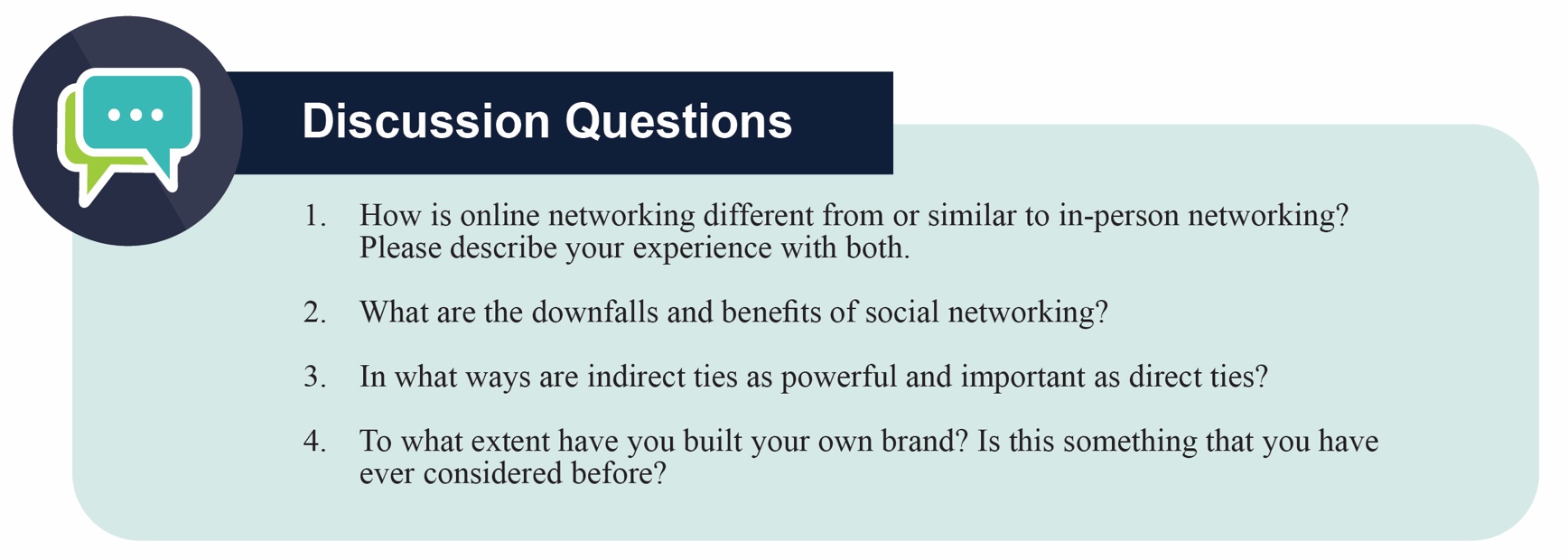
13.6 Conclusion
Power and politics in organizations are common. In most cases, each concept is necessary and executed with skill and precision. Unfortunately, power can lead to conformity from those around us, and this occurring conformity can breed corruption. The amount of power you have has strong ties to how much others depend on you. If you are deemed a valuable resource within an organization, then you are able to wield that dependability to make demands and get others to do what you want. Besides having an innate or acquired control over particular resources, there are several social aspects of power to draw on.
Methods for obtaining more power in an organization can often lead to political behaviours. As one person seeks to influence another to support an idea, politics begins to play out. Though necessary in some instances, many people that follow the rules see the politics of an organization as resulting in an unfair distribution of resources. Still others, despite understanding the politics of a given organization, see it as an unnecessary time consumer.
Politics, influence, and power can often reside within your social network. When an individual is core to a social structure, they will often have some degree of control over others. Social networks can also help you acquire jobs, make beneficial connections, and generally make life easier. It is often a good idea to analyze your social network and determine if it needs to be strengthened or tailored.

